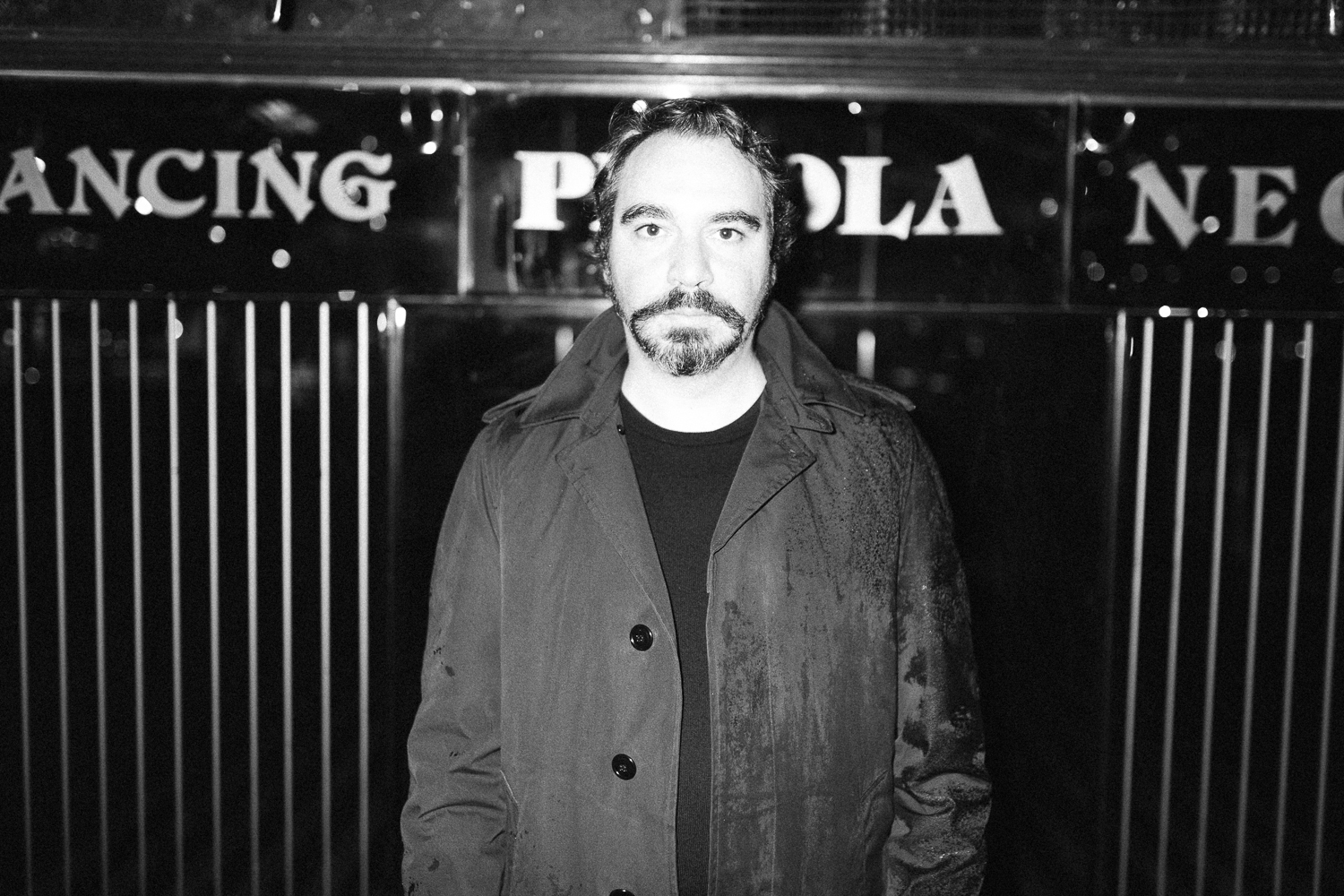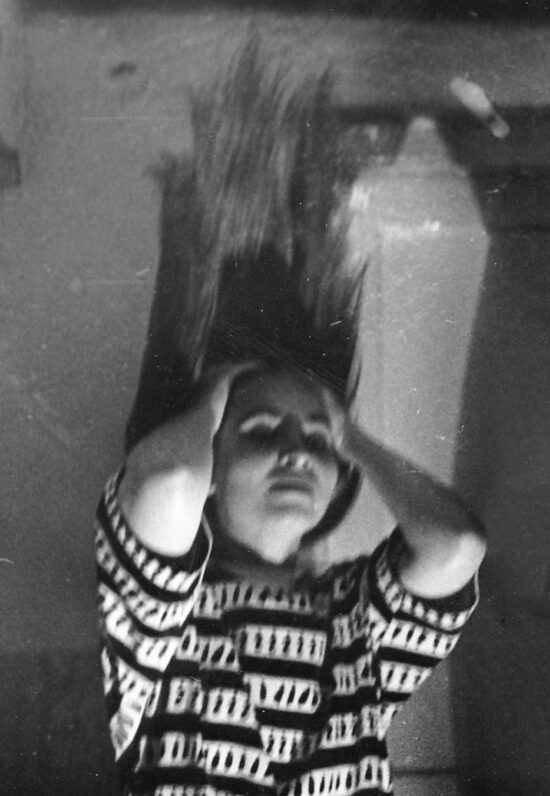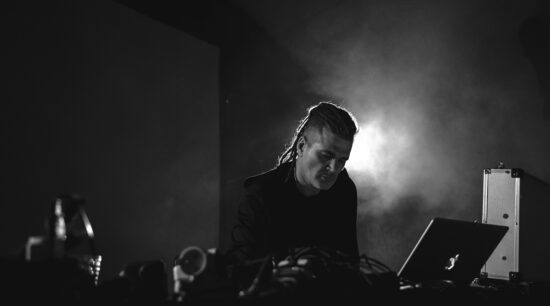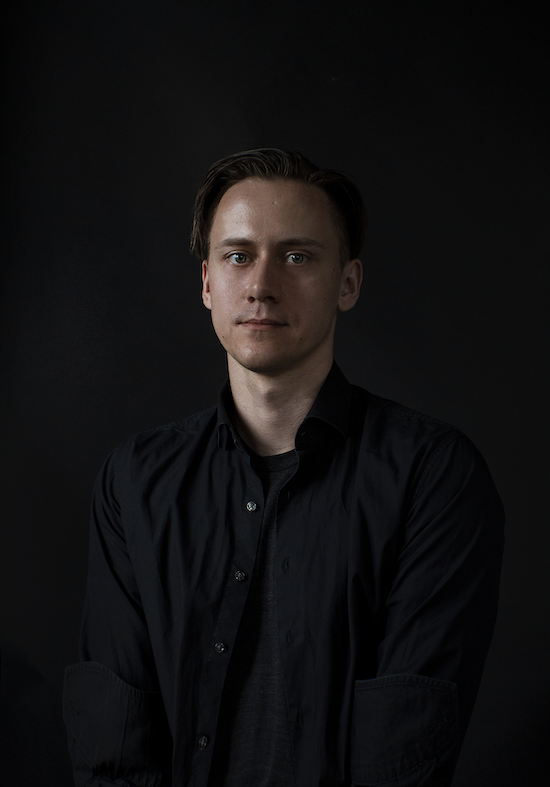– I know what the sound is going to be in the end. Before I start to record something, I’m making cymbals on purpose for that. If I have the sound in my mind, I’m trying to reproduce it on a cymbal or gong. I always have new ideas which come to me when I want to make a new record – I always develop new elements – says João Pais Filipe, a drummer and sculptor.
Photo: Renato Cruz Santos / Translation: Aleksandra Szkudłapska
This conversation was supposed to happen a few times. First, before the 2019 Unsound Festival , where João Pais Filipe played three sets, then at the beginning of 2020. Finally, we managed to talk in the second half of the pandemic year. There were many reasons – during the last 10 months, the Portuguese drummer released no fewer than 5 albums, and more are still to come.
João Pais Filipe is an extraordinary and original musician in terms of performance techniques. I had the opportunity to see him playing solo at the Tremor festival in 2019, when – using the unusual acoustics of a car garage that served as his venue – his music was intense, trance-like, indigenous, but also techno-like. The drummer from Porto is characterized by an extraordinary motoric sound, he hardly uses the kick drum at all, but he nuances the rhythm very well, playing on the floor toms, hi-hats and gongs. He creates gongs and cymbals on his own, expanding his musical sound arsenal as a sculptor. Not only do they have remarkable acoustic qualities (each is designed differently), but also visual ones – due to the texture, material and unusual sculptures that Pais Filipe places on them.
2020 showed his extremely broad horizons – from his motoric, krautrock incarnation with Burnt Friedman, through a more progressive style with GNOD, the powerful, metal sound with Julius Gabriel as Paisiel, but also an exploration of resonance and electronics with Rafael Toral. It is also the year of his second solo album, Sun Oddly Quiet. Below you will read about his musical path, his fascination with metallic sounds and Einstürzende Neubauten. At the end of the text is a brief review of his albums from the past months. If you missed out, now is the time to catch up.
JAKUB KNERA: How did you start playing drums?
JOÃO PAIS FILIPE: I started in the 90s. From the very beginning, I always tried to incorporate new things into my drums. I was fascinated with new elements and not just the standard jazz or rock kit. I used metal pieces, everything I could find and reasonably use in the instrument, and then I played it as part of my drumkit.
Did you learn to play drums by yourself?
I started to play by myself. I took private classes, but that was much later, somewhere in the middle of 2000. I have a lot of influences – I started playing by watching, learning and practicing.
Did Portuguese music influence the way you play drums in any way?
I don’t like to put any specific cultural influence into my music. It’s something that doesn’t interest me so much. I don’t think I have any direct influence from music from Portugal.
You said you wanted to sound different and incorporate different elements into you drum set. How did this idea of playing beyond the normal drumkit occur to you?
I was also very much into industrial music – I love Einstürzende Neubauten. I was fascinated by their percussion setup; they use all these crazy metal elements and I was very influenced by them.

They were your first most inspiring band?
Yes. That’s why I didn’t start playing “normal” drums. I progressed onto other things later. King Crimson were a major influence on me, especially their records from the 70s. They also have this amazing percussionist called Jamie Muir, who also played with Derek Bailey and Evan Parker. I like the way he played and what he used – it was very unconventional for me. I also like Tony Oxley, who was more into the free-improvisation thing, but he develops his drumkit, the sound and textures. Nowadays I’m more into rhythm, but I love all these textures and sounds. CAN with Jaki Liebezeit was a huge influence on me.
I’m curious about this Einstürzende Neubauten thing – I didn’t think about them through the context of your music, but now it seems obvious when I’m comparing your sound to theirs. You’re sculptor too and you are making some elements of your equipment yourself. What was first – João the musician or João the sculptor?
I started making cymbals and gongs when I already was a musician, it was more or less 10 years ago. Before that I used everything I could find – metal tools, xylophone, oil boilers, which also sound great. Later I started to experiment with cymbals that I had. I was hammering them, at the beginning of course with poor results, because I was still learning. Once I got the book Percussion Profiles, which is about amazing drummers and sculptors, like Steve Hubback, Le Quan Ninh or Tony Oxley. I realized that I can make my cymbals or gongs with a more sculptural approach, where the sound is important but the visuals too. I started to learn how to make it and incorporate more sculptural elements into my cymbals, gongs and bells – I’m still developing that.
How do you make them? Do you have an idea of the sound and you’re trying to find it, or you create them and if the sound is acceptable, play them?
In the beginning it was trickier – I was just making them and checking their sound. Now I know what the sound is going to be in the end. Before I start to record something, I’m making cymbals on purpose for that. If I have the sound in my mind, I’m trying to reproduce it on a cymbal or gong. Sometimes it’s difficult, especially if I have weird ideas. But the way you develop that is also interesting. I always have new ideas which come to me when I want to make a new record – I always develop new elements.
Is there any specific sound or equipment that surprised you the most? I remember your concert at Tremor 2019 in the Azores – you used one of the cymbals with a sculpted face, but you played it using a pedal. It was interesting because of the way you reproduced the sound but also because of how you played on it.
I don’t do this anymore – I’m not playing the gong with a pedal foot. Actually, it was not my idea, but that of the English percussionist Paul Buyer. He was playing gongs with his feet. This is perfect when you are playing the drums and you can add some independent textures over it – that was my previous idea to put it on top, so that I could control the dynamics and intensity. Now I prefer a more primitive approach to my drumming and nothing else around it. I’m interested only in drums, pure cymbal sounds.
I remember the faces you put on cymbals. Is this meant to be a magical element of your music?
I think about it as something symbolic. You look at the gong, see the face, and when the gong plays, it looks like it talks. It also has much richer tones and overtones sound-wise. It’s very sculpted in the metal and you have different sounds than in the normal gong. They have different sounds and you have to know exactly how to make them – otherwise you can damage the gong.

Your drum set is very rich in the sound. You mentioned Einstürzende Neubauten, which reminds me of a much slower way of playing. What is characteristic for you is this kind of motoric way of playing. To what extent are you interested in these two perspectives?
I started to change my drum set to play just with my hand, which is nothing new. This is more primitive in a way, but also more futuristic on the other hand. That’s how the gongs and special sounds that I used came to my mind – this is related to Einstürzende Neubauten because at the beginning I was really impressed by them. Not only by the way they used the instruments, but also by the sounds they create, especially using the metal. At the beginning they were very minimal and repetitive and I’m really interested in the fusion of these two elements: different, weird – in a good way – sounds mixed with repetitiveness. I don’t like to call it repetitive to be honest – in drumming you always have to have repetition; rhythm is always based on it.
Over the last few months, you’ve released albums with different bands. I read your interview with GNOD – they admire your way of playing. I could say it is very original and characteristic – when you play with other musicians, I can always hear that it is João Pais Filipe. I cannot mistake you with any other drummers. It is exactly the same with Faca De Fogo which you released with them. Do you think about the way you’re playing at a point which you wanted to achieve and feel good with this aesthetic?
This is a very interesting question. If you find a comfortable place, you can stay there, and you can do it forever. But I always try to invent new things, I keep exploring them. Of course, with time you reach your own way – you’re starting to have some character and personality, you can relate to someone. But that doesn’t mean that you are constantly searching for new things which is the way that I work. With these collaborative projects I always to play together like a band, not a collaborator. This is not me playing with Gnod or Black Bombaim – which is a selfish way to do it – but we’re playing together, and I hope the records sound like we and not like me and them. Of course, we have our characteristic sounds, but it only makes sense when everything comes together as a whole.
The record Dragonflies with Birds and Snake with Black Bombaim is like a supersize version of the band, rather than a simple collaboration, because of the two drum sets.
You have to adapt and not just do your own thing. With Black Bombaim, who are good friends of mine, it was interesting to develop the soundtrack for Dragonflies with Birds and Snake, a film by Wolfgang Lehmann. I’m very happy with the results.
You also released your second solo record Sun Oddly Quiet, which is quite surprising in terms of talking about your style. It has this ambient sond and very minimalistic approach. Can you tell me more about your idea for it?
Before I recorded it, I spent a lot of time developing the rhythm, which is very specific for each track. They are very complex in a way – the titles show the number of grooves in each piece, “XV” is the fifteen groove, “XIII” is thirteen, “XI” is eleven, which is very common in the Middle East and it’s called “the rhythm of eternity”. The last one is “V”, which is very common in Turkey and the Balkans.
I spent most of the time on developing those rhythms – it was my main source of work and inspiration. At the same time, I wanted a minimal sound, without adding too much, just a straight groove with a few things going on. If you add too much to attract attention, something is wrong. If you listen to “XV”, there’s almost nothing except for the toms – I make some changes, but it is full on repetition of this element of the drum set. It works best that way – without adding something on top to have some sort of a climax – it is very common in the West, but in Asia; there’s no beginning or end of the records. That was my inspiration too.

How did you start to get more interested in non-Western music?
I’ve always been interested in this music as well as in ethnic things. In the last years I was very interested in Middle Eastern and Turkish music, so most of the rhythms are inspired by this tradition.
You mentioned ethnic music – can this label be used to describe your music in a way?
I don’t like to associate my music with anything (laughs), especially culturally – I’m trying to avoid these things. I was telling you about what I’m more interested in now, but I don’t want to be connected to this aesthetic. I’m not inventing anything new but it’s important to have some my own characteristic which you don’t need to identify with anything else.
There are also other records you made this year: my favourite is Unconscious Death Wishes by Paisiel, a duo with Julius Gabriel. Where Sun Oddly Quiet was minimal, this second record of your duo has a very huge sound. You’re using a lot of effects, almost like a rock band, maybe Swans-like. This is quite the opposite of what you were saying about your solo record.
We didn’t have any specific ideas – we’ve been talking about the grooves and what the sound would be like. The interesting element of this record is that it was recorded in one take without stopping for 40 minutes. For the vinyl, you will hear it divided in two parts, but this is in fact a single track, it was recorded non-stop. It was a challenge – it’s really hard to play musically and physically on drums for such a long time. I’m really happy to have achieved this. It sounds much bigger and more powerful, Julies is very epic in playing in a way, which had an influence on me.
How do you prepare for playing for such a long time? And how do you prepare for playing in general? I remember talking to Colin Stetson – he breathes a lot when he plays the saxophone, and described it as very exhausting physical work. How does it work when you’re playing drums for such a long time?
Now it’s more natural. If you know that you’re going to be playing non-stop for an hour, you have to be careful, especially if you’re playing repetitive things, because you can get in really serious trouble with your arm or hand, especially if you don’t know how to manage them at the time. You have to be relaxed – if you’re tense, you’re done.
There are also other duos in which you played: Eurydike with Burnt Friedman but you are also going to release a new album as CZN with Valentina Magaletti. Tell me more about your perspective on duos.
I’ve always played in duos, ever since I started out. Two people playing together are perfect for me. With Valentina we’re together just a few times in a year, because she lives in London and I live in Porto. But every time we meet for a recording or a gig, it always works. We work for a long time. Burnt Friedman now lives in Porto – basically we work together almost every day.

Despite the pandemic year, you released five albums, which is quite unbelievable. The last record I would like to talk about is Jupiter and Beyond with Rafael Toral, which was recorded – as the press release says – almost by accident. You use the drumkit in a very different way.
A few years ago I had an accident – I broke my arm and had to stop playing for a few months. I had to cancel some gigs, but instead of cancelling some solo gigs, I suggested I could make gong concerts. I became more interested in making solo concerts just using them. With Rafael, we started playing a few years ago – I used to play in his Space Quartet. Once he was in Porto, we recorded a very nice piece of just gongs and electronics.
It seems that you’re recording a lot and even when you have some injuries, you can still play anything, for example just with gongs.
We’re just about to release two albums as CZN. In January we recorded a new album with HHY & The Macumbas and it should be out soon. As well as a long play record with Burnt Friedman.
Even though we have a global pandemic, you are very busy!
Yeah! I think that’s what people should do: never stop! (laughs). You should go full on.
João Pais Filipe in 2020
Solo: Sun Oddly Quiet, Holuzam/Lovers & Lollypops
Pais’s second solo album is a journey towards minimalism and hypnosis. The titles define the groove of individual pieces, which often come from distant worlds: “XI” is typical for the Middle East, and “V” for Turkey or the Balkans. Filipe, however, does not play ethnically, nor does he delve into ornamentation. It seems that the most important thing for him is the repetitiveness of the pattern and small ambient outlines in the background, often interestingly painted with gong strikes. Very focused, engaging and mature, full of hidden resonances and structures that emerge from under the drumming in the foreground.
With GNOD: Faca de Fogo, Rocket Recordings/Lovers & Lollypops
The Portuguese drummer is not a guest here, but a full-on band-member – especially since the British collective is regularly visited by a changing group of musicians. From the first minutes of “Faca de Terra”, you can hear his characteristic style of playing the toms, upon which the rest of the group add layers of keys, guitars and vocals. The sound is heavier in the title track, the drums seem more march-like in the company of guitars, ethnic flutes and shoegaze voices; there is not so much of Pais’s characteristic motorik here. But Filipe emphasizes the regularity of the sound and construction of his part of the rhythm section at every step.
With Burnt Friedman: Eurydike, Nonplace
Motorized electrification of dance music. In “Out of Ape”, the duo creates cosmic mechanics, densely entwined with the sound of Moog and electronic layers. You can hear the ethnic sound of Pais, but here it takes on a very modern taste mainly due to the density of the music. If the first track seems quite monotonous, “Fibers of P” keeps on growing, and additional ornamentation in the form of muffled electronics in the background or reverbed gongs reinforces this mantric story. On the other side, Friedman is accompanied by Jaki Liebezeit – it is worth comparing him to Filipe, because you can hear how characteristic his style is.
With Rafael Toral: Jupiter And Beyond, Three:four Records
Filipe abandons the classic drum kit in favour of gongs and cymbals. They resonate, their metallic sound shimmering with different colors, while Rafael Toral prolongs it with the help of electronics. The music becomes denser and modified, often diverging from the original sound – sometimes in a more ambient, light form, and sometimes gaining a drone-like weight. Very often, the duo makes a recycling of sorts: they mix acoustics and electronics to such an extent that we stop focusing on details and their source, but on the overall effect.
With Julius Gabriel as Paisiel: Unconscious Death Wishes, Rocket Recordings
This album is a ginormous, overwhelming wall of sound and a percussive mantra that keeps growing. This one track can be compared with Swans or Godspeed You! Black Emperor, with the exception that here the music is only created by two people. Pais plays continuously for 40 minutes – he develops the rhythm and beats on individual drums, skillfully building tension. German saxophonist Julius Gabriel amplifies his saxophone with a lot of effects, which make it sound like guitars plugged into amps. The whole thing hits you with its monumentality, and if the apocalypse comes, this will be its soundtrack.





